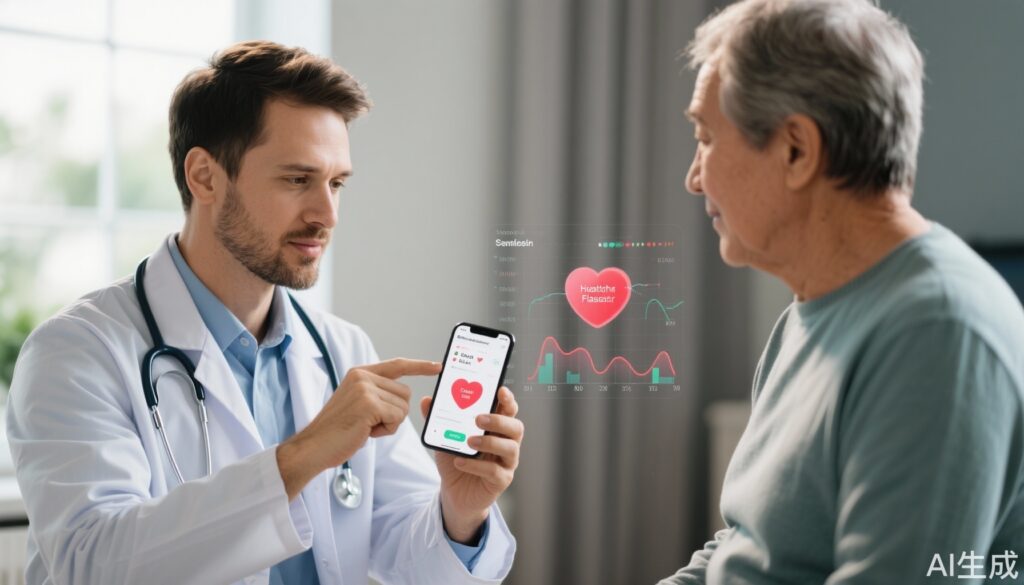Highlight
- A novel mobile phone application was used in primary care to screen for previously undiagnosed heart failure (HF), detecting HF in 34.1% of screened patients.
- The majority of newly diagnosed HF cases were HF with preserved ejection fraction (HFpEF), accounting for 70.1%.
- The newly developed ECHOS3 score demonstrated high sensitivity (88%) for HF screening but limited specificity (35%), providing a useful tool for early identification.
- Key predictors of HF included advanced age, atrial fibrillation, coronary artery disease, abnormal ECG, chronic kidney disease, and long-standing hypertension.
Study Background and Disease Burden
Heart failure (HF) remains a significant global health challenge due to its high morbidity, mortality, and healthcare costs. Its prognosis closely parallels that of some common cancers, emphasizing the urgent need for early diagnosis and intervention. However, HF, especially HF with preserved ejection fraction (HFpEF), often remains undiagnosed in primary care settings due to its nonspecific symptoms and the requirement for specialized diagnostic tools such as echocardiography and biomarker assays.
Recent advancements in mobile health technologies offer potential solutions to bridge this diagnostic gap. The Echocardiographic Society of Serbia initiated a pioneering multicenter program to leverage a mobile phone application (app) to facilitate HF screening in primary care by identifying individuals at high risk or with early symptoms warranting further diagnostics.
Study Design
This large-scale, multicenter screening program involved 1028 outpatients without previously diagnosed HF, assessed between 2023 and 2025. General practitioners utilized a custom-designed mobile phone app to evaluate patients based on cardiovascular risk factors and HF-related symptoms. The app algorithm recommended referral for echocardiographic evaluation and natriuretic peptide testing when criteria indicating possible HF were met.
HF diagnosis included all phenotypes classified per the 2021 European Society of Cardiology (ESC) guidelines encompassing HF with preserved ejection fraction (HFpEF), mildly reduced EF (HFmrEF), and reduced EF (HFrEF).
Key endpoints included the prevalence of newly diagnosed HF, phenotype distribution, and identification of clinical predictors. Additionally, the study introduced the ECHOS3 score, derived by refining cutoff thresholds of traditional HF risk factors for optimized screening performance.
Key Findings
Among the 1028 screened patients (mean age 66 ± 11 years; 55% female), 351 individuals (34.1%) were newly diagnosed with HF. The distribution of HF phenotypes was predominantly HFpEF (70.1%), followed by HFmrEF (14.2%) and HFrEF (15.7%).
Multivariate regression analysis revealed several independent predictors strongly associated with newly diagnosed HF: advanced age, atrial fibrillation, established coronary artery disease (CAD), abnormal electrocardiogram (ECG), chronic kidney disease (CKD), and long-standing hypertension. These findings reinforce established clinical risk factors and their role in primary care HF identification.
The newly developed ECHOS3 score, which adjusted traditional risk factor cutoffs, yielded a high sensitivity of 88%, enabling effective screening of at-risk populations. However, its specificity was modest at 35%, indicating a higher rate of false positives which could lead to additional downstream diagnostic testing.
An important clinical insight from this study is the utility of app-assisted risk stratification particularly in patients with borderline natriuretic peptide levels. Such patients are frequently challenging to diagnose in routine care, and app-facilitated screening can guide appropriate referral and early therapeutic interventions.
Expert Commentary
This study represents a significant advancement in leveraging digital tools for cardiovascular disease screening in primary care. The high detection rate of de novo HF cases, especially HFpEF, highlights the app’s potential to address underdiagnosis in a phenotype that often evades early recognition.
Despite its promising sensitivity, the suboptimal specificity of the ECHOS3 score suggests that it should be used primarily as a screening tool warranting confirmatory diagnostics rather than a standalone diagnostic method.
Limitations include its observational design and the setting limited to the Serbian healthcare system, potentially affecting generalizability. However, the findings align with international efforts to integrate digital health platforms into routine care, especially in resource-limited settings where echocardiography access is restricted.
Biologically, the identified predictors reflect the interplay between cardiac structure/function and systemic comorbidities such as hypertension and CKD, which precipitate HF development. Early identification enables timely lifestyle modifications and pharmacotherapy targeting these mechanisms.
Conclusion
The ECHOS3 registry demonstrates that a mobile phone application used by general practitioners can effectively identify a substantial proportion of previously unrecognized HF cases in the primary care setting. The predominance of HFpEF underscores the importance of screening phenotypes less apparent with conventional heart failure diagnostic approaches.
While the high sensitivity of the ECHOS3 score facilitates early detection, efforts to improve specificity will enhance its clinical utility and cost-effectiveness. Future directions include integrating biomarker data and machine learning algorithms to refine predictive accuracy.
Overall, mobile app-assisted screening represents an innovative, scalable strategy poised to improve HF diagnosis rates and enable earlier patient management, ultimately reducing morbidity and healthcare burden associated with heart failure.
References
Stefanovic M, Trifunovic-Zamaklar D, Mladenovic Z, et al. Utility of Mobile phone app-assisted screening for heart failure in primary care: Insights from the ECHOS3 registry. Int J Cardiol. 2025 Nov 15;439:133651. doi: 10.1016/j.ijcard.2025.133651. Epub 2025 Jul 22. PMID: 40706806.
McDonagh TA, Metra M, Adamo M, et al. 2021 ESC Guidelines for the diagnosis and treatment of acute and chronic heart failure. Eur Heart J. 2021;42(36):3599-3726.



